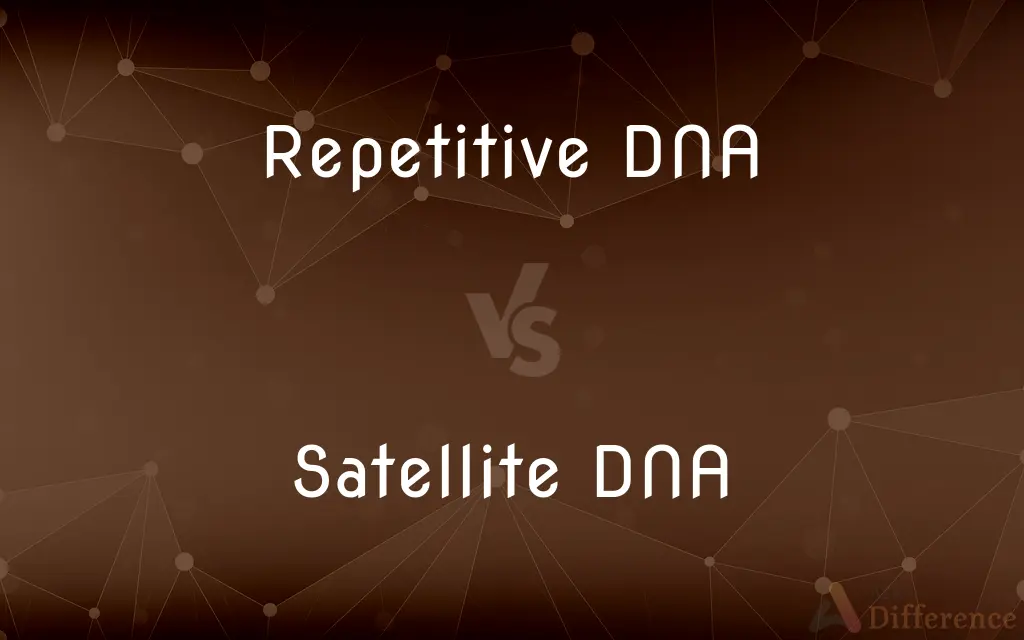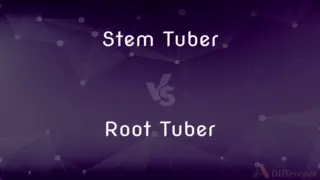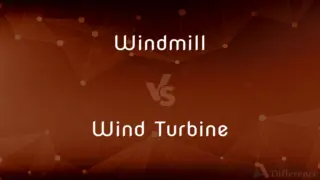Repetitive DNA vs. Satellite DNA — What's the Difference?
By Tayyaba Rehman — Published on November 10, 2023
Repetitive DNA consists of sequences that recur numerous times in a genome, while Satellite DNA is a subset of repetitive DNA found mainly in heterochromatin regions, characterized by tandem repeats.

Difference Between Repetitive DNA and Satellite DNA
Table of Contents
ADVERTISEMENT
Key Differences
Repetitive DNA encompasses DNA sequences that appear multiple times throughout a genome. These repeating units can be found scattered or in tandem, and they play vital roles in the genome's structure and function. From the organization of chromosomes to certain regulatory functions, Repetitive DNA has broad implications for genomic architecture.
Satellite DNA, on the other hand, is a specialized form of Repetitive DNA. Primarily located in the heterochromatin regions of chromosomes, especially at centromeres and telomeres, Satellite DNA is composed of very short sequences repeated in tandem many times. The name "satellite" originated from the observation that, during centrifugation, these sequences produced secondary or "satellite" bands distinct from the main DNA.
While all Satellite DNA is Repetitive DNA, not all Repetitive DNA can be classified as Satellite DNA. Repetitive DNA is an overarching term that includes other types besides just Satellite DNA, such as minisatellites and microsatellites. The distinction lies in the length of the repeating unit and the location within the genome.
In essence, the realm of Repetitive DNA is vast and varied. Within it, Satellite DNA is a particular subset that has garnered attention due to its presence in specific genomic regions and its potential roles in chromosome segregation and stability. To visualize the relationship, consider Repetitive DNA as a broad category, with Satellite DNA being one of its specific members.
Comparison Chart
Definition
DNA sequences repeated many times in a genome.
Subset of repetitive DNA with tandem repeats.
ADVERTISEMENT
Location
Throughout the genome.
Mainly in heterochromatin regions like centromeres.
Types
Includes satellite DNA, minisatellites, microsatellites, etc.
A specific type of repetitive DNA.
Repeat length
Can vary widely based on the type.
Very short sequences repeated in tandem.
Function
Genome structure, regulation, and more.
Implicated in chromosome segregation and stability.
Compare with Definitions
Repetitive DNA
Crucial for certain genomic and regulatory functions.
The presence of Repetitive DNA can impact gene expression in some contexts.
Satellite DNA
Found predominantly in heterochromatin regions of chromosomes.
Satellite DNA plays a role in the formation of centromeres.
Repetitive DNA
Sequences that recur numerous times throughout a genome.
Scientists were intrigued by the high amount of Repetitive DNA in some organisms.
Satellite DNA
A specific subset of Repetitive DNA characterized by tandem repeats.
Satellite DNA bands were observed during centrifugation experiments.
Repetitive DNA
Plays roles in chromosomal structure and function.
Repetitive DNA aids in maintaining chromosome integrity.
Satellite DNA
Implicated in chromosome segregation and stability.
Abnormalities in Satellite DNA might lead to chromosomal issues.
Repetitive DNA
DNA segments that can be scattered or appear in tandem.
In some cases, Repetitive DNA forms significant portions of a genome.
Satellite DNA
DNA sequences that produce distinct "satellite" bands.
During density gradient centrifugation, Satellite DNA separates uniquely.
Repetitive DNA
Broad category encompassing various types of repeated sequences.
Minisatellites and microsatellites are forms of Repetitive DNA.
Satellite DNA
Very short repeated sequences located in specific genomic areas.
The short, repeating units of Satellite DNA have been studied for potential roles in genome function.
Common Curiosities
How does Satellite DNA differ?
Satellite DNA is a specific type of Repetitive DNA, mainly found in heterochromatin regions with very short tandem repeats.
What roles does Satellite DNA play?
It's implicated in chromosome segregation, stability, and potentially gene regulation.
What is Repetitive DNA?
Repetitive DNA consists of sequences that are repeated many times throughout a genome.
Where is Satellite DNA primarily located?
Mainly in heterochromatin regions, especially at centromeres and telomeres.
Why is it named "Satellite" DNA?
Because of the distinct "satellite" bands it produces during centrifugation.
Is all Satellite DNA a form of Repetitive DNA?
Yes, all Satellite DNA is a subset of Repetitive DNA.
How do the repeat lengths differ?
Repetitive DNA can vary widely, while Satellite DNA consists of very short tandem repeats.
How does Satellite DNA contribute to chromosome structure?
It plays a role in the formation and function of regions like centromeres.
Is Repetitive DNA always in tandem repeats?
No, while some are in tandem, others can be scattered throughout the genome.
Does Repetitive DNA play a role in genomic functions?
Yes, from structural roles in chromosomes to potential regulatory functions.
Is Repetitive DNA found in all organisms?
Most organisms have some form of Repetitive DNA in their genomes.
Do changes in Repetitive DNA have genetic implications?
Yes, alterations can lead to genomic disorders or play roles in evolution.
Can Repetitive DNA impact gene expression?
In certain contexts, the presence of Repetitive DNA can influence gene expression.
How was Satellite DNA discovered?
Through centrifugation experiments that revealed distinct DNA bands.
Are there other types of Repetitive DNA besides Satellite DNA?
Yes, including minisatellites, microsatellites, and more.
Share Your Discovery

Previous Comparison
Stem Tuber vs. Root Tuber
Next Comparison
Windmill vs. Wind TurbineAuthor Spotlight
Written by
Tayyaba RehmanTayyaba Rehman is a distinguished writer, currently serving as a primary contributor to askdifference.com. As a researcher in semantics and etymology, Tayyaba's passion for the complexity of languages and their distinctions has found a perfect home on the platform. Tayyaba delves into the intricacies of language, distinguishing between commonly confused words and phrases, thereby providing clarity for readers worldwide.












































